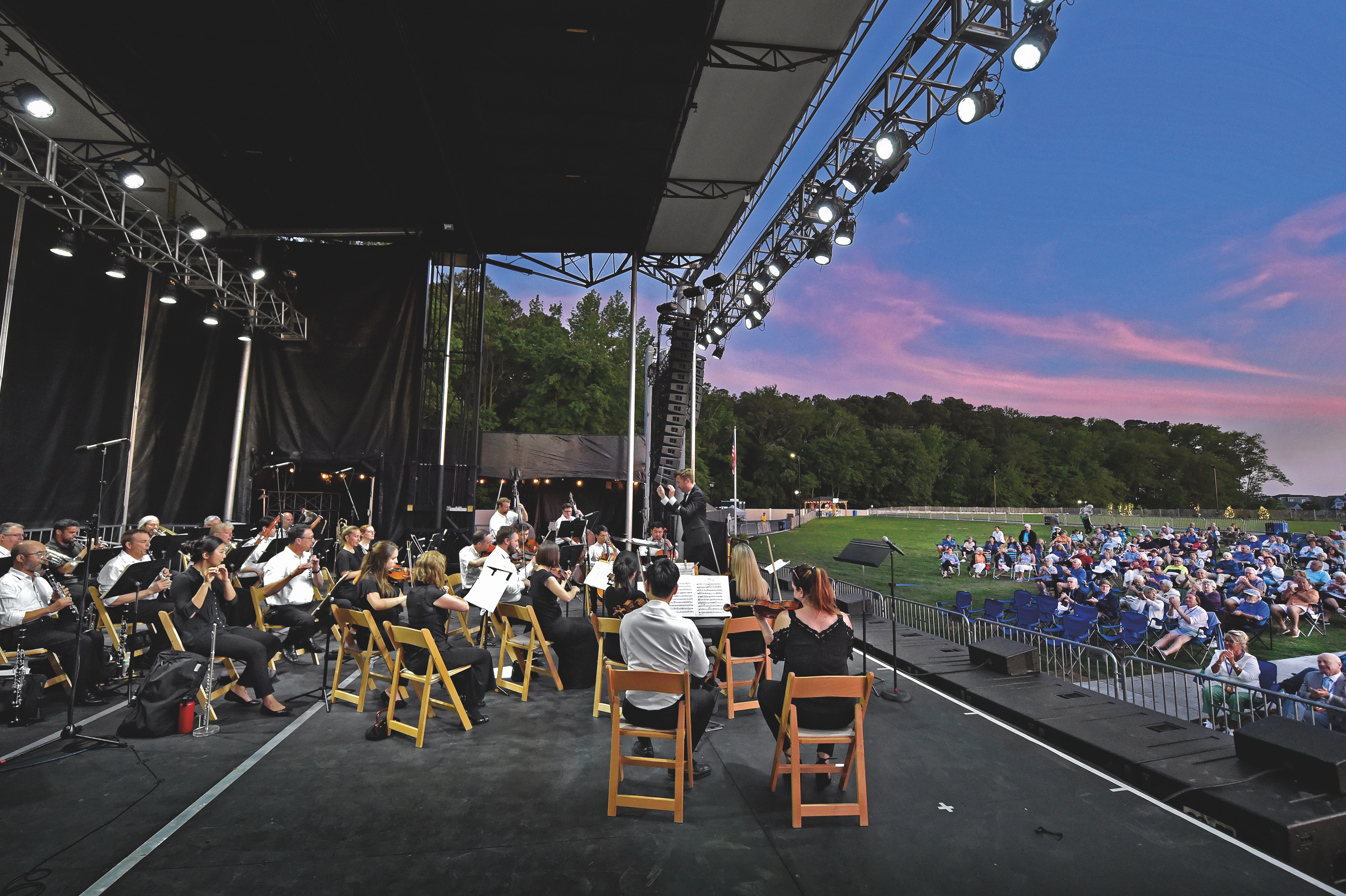
The Freeman Arts Pavilion is marking its 15th year with big sounds — and bigger plans
By Bill Newcott
Photograph by Butch Comegys
From the August 2022 issue

Asked to recall the earliest days of the Freeman Arts Pavilion in Selbyville, orchestral percussionist Dane Krich hears crickets. No, not the “I can’t think of anything to say” kind of crickets. He’s thinking real, chirping crickets.
“This was when the Freeman Stage was just a wooden platform, over by that pond,” Krich says, indicating the squared-off body of water that lies between the Freeman and a bank of four-story condominiums.
“We were playing, and all of a sudden there was this enormous chorus of crickets coming from the pond. It was crazy. You could hear them over the orchestra. Finally, the maestro, Julien Benichou, leaned over in that direction and yelled, ‘You’re chirping out of tune!’”
That was 13 years ago, and a lot has changed since Krich’s first Freeman performance with the Mid-Atlantic Symphony Orchestra. He’s now the orchestra’s chief percussionist and manager — and the Freeman’s performance space has grown from a compact beer garden-sized parcel to a vast festival-grade spread with a state-of-the-art sound system and elaborate collapsible stage.
“It’s different,” says Krich. Then he glances from backstage to the crowd of music lovers settling into their folding chairs, the sun settling toward the horizon behind them.“But it’s also kinda the same.”
This marks the 15th season for the showplace — which, with its transition from boutique performance space to sprawling venue has changed its name from the humble-sounding Freeman Stage to the grander Freeman Arts Pavilion.
“The name may have changed, and we’re certainly growing, but our mission has not changed one bit,” says Patti Grimes, who’s been executive director of Freeman from the get-go. “We’re here to transform lives through the arts — not just here at the pavilion, but in Sussex County and beyond.”
Like too many good things, the Freeman Arts Pavilion was born out of tragedy. On Dec. 14, 2006, businessman and philanthropist Joshua Freeman — developer of Bayside in Selbyville — died in a helicopter crash while en route from Delaware to Maryland. His widow, Michelle, soon began considering ways to memorialize her husband, a longtime patron of the arts who had served on the board of the Washington National Opera.
In March 2008, Freeman asked Grimes, who’d been vice president of sales and marketing at a for-profit company, to launch the first season of the Freeman Stage — which at that moment existed only as a spark in Freeman’s imagination and a small empty lot in Bayside.
“When do you want to launch it?” Grimes asked.
“How about Memorial Day?” Freeman responded.
So, Grimes had 45 days to fashion an inaugural season.
Luckily, she was surrounded by resources: Beach towns are always booking talent for summer concert series, and program directors in places like Rehoboth Beach, Lewes and Bethany Beach were happy to point her toward acts that were already coming to the area that summer.
“We booked some tribute bands, some films — and the Mid-Atlantic Symphony,” she says.
But would anyone venture out to Bayside for what amounted to a pickup summer concert series?
Well, yes.
“That year, almost 10,000 people came,” Grimes says, still sounding a little mystified. “We thought, ‘Wow. Maybe we’re onto something here.’”
Since that surprising beginning, the Freeman Stage/Pavilion has welcomed more than 637,000 concertgoers for programs ranging from symphonic to country, from big band to classic rock.
As Grimes shows me around the grounds, we stop at the rectangular plot where it all started — that pondside patch, about the size of the facilities at a mid-sized tennis club — where the crickets nearly drowned out the orchestra. At the far end, opposite from where the stage once stood, is an upscale refreshment stand; a place for concertgoers to buy food and drink. I can imagine the space as accommodating a leisurely pre-show soiree. It’s impossible to picture 2,200 concertgoers cramming in here for shows — and doing so for well over a decade.
“Yeah, it was pretty crowded,” Grimes admits.
Still, nearly from the start, the Freeman Stage drew a remarkable collection of big-name talents: Huey Lewis, Melissa Etheridge, Pat Benatar, The Beach Boys, Troy “Trombone Shorty” Andrews, Sheryl Crow and others all funneled big-city showbiz glitz onto a modest, low-lying stage that would not have looked out of place at a Midwest county fair.
That stage was demolished at the end of the 2016 season and replaced with something more substantial, offering better lighting and improved sightlines. It was also the year that Grimes finally felt the place was truly on the trajectory she and Freeman dreamed about in 2008.
“Yo-Yo Ma was here, performing with the Silk Road Ensemble on that original, little wooden stage,” she recalls. “He was backstage with me and Michelle; we were just having a little conversation, and suddenly he put his arm around me and said, ‘Keep doing what you’re doing. This is so needed!’
“Well, that caught me by surprise. Here was this man who had performed in the world’s most beautiful concert halls, standing backstage at this little stage with maybe 1,800 people out there. If he could see our vision and get as excited about it as we were — well, that was a turning point for me.
“I knew then that we could not only keep doing what we were doing, but also to push to the outer limits.”
Of course, ambition does not always translate into success. But besides offering a cozily intimate venue and a wildly appreciative audience, it so happens that Selbyville is in a touring company sweet spot: a convenient stop-off for acts traveling up and down the East Coast.
“Usually a tour likes to stick to a five-hour drive between venues, or else they’ll end up taking a day off,” says Grimes. “An act passing through Delaware could be coming from Virginia Beach, or Richmond, or the Carolinas, heading for Boston or the other way around, and for them we’re perfectly situated.
“Other groups sometimes just take a year off from playing the large sheds, like Wolf Trap or the Nissan Pavilion, and they want to play smaller venues instead.
“Either way, for us it’s pretty amazing.”
It is no surprise that when Diana Ross came to the Freeman in 2019, she did not make a side trip to ride the bumper cars at Funland. But if some big-name celebrities like Ross prefer to hunker down in their tour buses, others embrace the unique beach/country vibe Freeman offers.
“Jay Leno ate Royal Farms chicken,” Grimes recalls. “The Beach Boys went to the Crab Bag in Ocean City. St. Paul and the Broken Bones, the soul band, had a fishing tournament in the pond. Jake Owen and Darius Rucker played golf on the course here. Lyle Lovett loves our crab cakes.
“We help the artists with those things as much as we can. Because an artist will often get off that bus, look around, and ask, ‘Where are we?’
“Harry Connick Jr.’s tour managers tell people one thing about us: ‘It’s a simple venue, but great people. They know what they’re doing and they treat us well.’”
As it turns out, the Freeman pavilion treats more than its artists and audiences well: The place has become an economic powerhouse for the lower reaches of coastal Delaware.
“We worked with the University of Delaware to create an economic impact study,” says Darren Silvis, Freeman’s development director since 2020. “And we found that our economic output since 2008 has been over $97 million. That’s no small potatoes in just a short period of time.”
That same study revealed that for every dollar spent on a ticket at the Freeman, $1.89 goes into the community in spending outside the venue.
And while Freeman is known mostly for its ticket-driven shows, Grimes is quick to point out that 40 percent of Freeman-related entertainment offerings are free to the public through its Arts Access Initiative.
In the Freeman’s greenroom — the nicely furnished trailer in which headliners cool their heels before going onstage — Grimes points out a line of photos on the wall: alternating images of top-tier celebrities and groups of children participating in music making and appreciation programs.
From the beginning, Freeman’s programming for children has included free events both at the Selbyville facility and in schools — where kids sing, dance and create under the guidance of trained artists. And now, after two pandemic-plagued years in which Freeman had to refrain from conducting classroom outreach programs, “we’re back in the schools!” Grimes says triumphantly. “Thousands of children will have live arts programming once again. We’ll have musical theater — and we’ll even have an artist who plays Creole music, which is important because there’s a large population in western Sussex County with Creole as their native language.”
We head outside, to the middle of the enormous rectangle of land the Freeman pavilion has occupied since installing its large, collapsible stage a couple of years ago. The stage stands at the middle of one of the rectangle’s long sides, facing west and overlooking the venue’s expansive grassy field. For the Mid-Atlantic Orchestra, which will draw a relatively light crowd, most concertgoers will bring their own folding chairs and scatter themselves randomly near the stage. When big-name acts perform for larger audiences, the half of the field closest to the stage has assigned seating while the more distant half is a free-form tangle of music lovers who bring their own chairs or settle down atop blankets on the fine-cut grass.
It’s an impressive setup, but don’t get too fond of it: After this season, Grimes & Company will be starting all over again, this time moving the stage to the far south end of the rectangle. Over the next few years — in an estimated $27 million overhaul —
the now-flat field will be graded to an amphitheater-like incline. Closer to the stage, a covered section will protect 1,000 patrons from the elements, enabling them to stay dry during shows, rain or shine.
In a design reminiscent of its big brothers and sisters at Wolf Trap and the Merriweather Post Pavilion, Freeman’s new Great Lawn will extend beyond the covered area, increasing the venue’s capacity to about 4,000 (still relatively modest: The Filene Center at Wolf Trap holds more than 7,000).
Just to the west, I can’t help but notice continuing residential construction across the pond. Yes, the stage is now farther away from those homes than ever before, but given the human need to complain about just about anything, does anyone gripe about having Lyle Lovett and His Large Band in their living room?
“Initially, yeah,” says Grimes. “But we’re 15 years into it. Now people say, ‘I bought here because I have arts in my backyard.’”
From backstage, the Mid-Atlantic Symphony’s Dane Krich squints into the early June sun, hanging low in an absolutely cloudless sky. Like the other musicians in this Easton, Md.-based orchestra, the Baltimore-based percussionist/manager counts the ensemble as one of several regular gigs. But, he hastens to add, there’s something unique about setting up his instruments at Freeman.
“It’s a special place, with a special audience,” he says. “Sometimes it gets a little glary, with that sun setting over there. Makes it hard to see the maestro.
“Then there was the time we were playing Tchaikovsky’s ‘1812’ Overture — and from where we were sitting, we could see this huge storm rolling in from the west. The wind came up like a hurricane. Our cellist had this big hair, and her hair started billowing in the wind. Then our music started blowing off the music stands.
“At some point, the audience started running. In all directions. Just, like, scattering. Mass chaos. Finally, the maestro had to stop conducting. And then we all ran, too.”
Unlike Tchaikovsky’s cannon-blasting showpiece, however, the storm offered no grand finale. In the end, it didn’t even rain.
“I was happy about that,” says Krich. “I was worried about my instruments.”
It’s showtime. The 7 p.m. sun is focusing its reddening yet still potent light directly onto the Freeman stage. Guest conductor Aaron Breid, who’s already vowed to the audience that “this jacket is coming off” in the evening heat, is leading the orchestra and mezzo-soprano Anna Kelly in a rendition of “Una voce poco fa” from Rossini’s “The Barber of Seville.”
The singer’s voice blends with the instruments, perhaps even more homogeneously than it would have in an enclosed space, joined by a soft evening chorus of birds in the trees beyond the stage and accompanied by the persistent whisper of a slight breeze.
Yesterday, this place was packed for a raucous show by 1970s disco legends K.C. and the Sunshine Band. Tonight the crowd numbers fewer than 1,000, leading Grimes to lament that I wasn’t here for the energy that a well-loved pop group can generate.
But there’s no need for apologies. The fact is, this relatively modest crowd — folding chairs pressing to the stage, cheering and whistling each climactic crescendo — is vindication for Freeman’s stubborn determination to feed the artistic appetites of audiences both large and small.
I scan the rear of the orchestra, seeking out Krich the percussionist.He’s wearing sunglasses.



